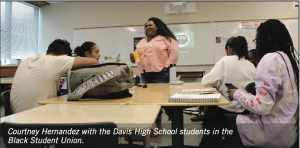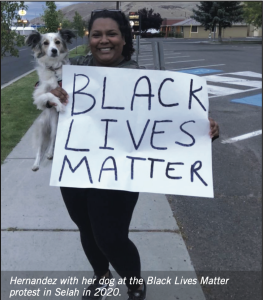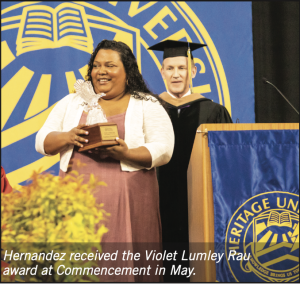The Courage to Stand Up
Growing up, Courtney Hernandez always felt a little out of place in her small hometown of Selah, Washington. She wasn’t like the other little girls with their blond pigtails and fair skin. Her complexion was decidedly darker, her hair a mass of chocolate curls. She was the only little girl in her school district whose parents were African American and Hispanic. And while she did all the same things as the other children—played sports, went to school, did her chores at home—she knew she was different. And so did those around her.
“At times, I was treated a little differently by my teachers, peers, and other kids’ families,” she said. “Until they got to know me.”
It wasn’t until Hernandez graduated from high school and moved to Seattle to attend the University of Washington that she fully appreciated what she experienced growing up in a community where racial and cultural diversity was limited. She was double majoring in social work and American ethnic studies. On one of her first days on campus, she walked into her African American Studies 101 class, and, for the first time in her life, she sat in a classroom full of students that looked like her and a teacher who looked like her.
“It was such a surreal experience,” she said. “It felt so empowering. When my teacher got up in front of the classroom and started to speak so powerfully, I was almost in tears, I was so touched by the experience. I felt like I was getting down to my roots and learning my cultural history for the very first time.”
That first class, and the variety of other ethnic studies courses with concentrations in other cultures, such as Native and Mexican American, opened her eyes to how much history was left out of her K-12 learning. There was so much about the American experience of ethnic minorities that she didn’t know, even within her own culture. Hernandez soaked in those lessons like a sponge.
“I was so eager to learn,” she said. “So many people are afraid to learn about those who are different, or they look down on them and think that education that includes their history and perspectives is dangerous or wrong, but diversity in education is a good thing. The more we learn about other cultures, and the history and the experiences of those different than ourselves, the more caring and understanding we can be of other people”.

Four years later, Hernandez graduated with a Bachelor of Social Work in 2014. She couldn’t find a position as a social worker, so she started teaching in a Seattle-area preschool. There, she learned her heart was really being in a classroom. Three years later, she moved back to Selah and enrolled in Heritage’s Master in Teaching program. She started teaching at Mount Adams Middle School while attending her graduate program. After graduating, she took a position at Lewis and Clark Middle School in Yakima, where she taught until she moved to Davis High School in fall 2021.
A CONSCIENTIOUS EDUCATOR
Davis High School and Hernandez’s alma mater Selah High School are a mere 5.8 miles apart. Despite their close geographic proximity, the student makeup is decidedly different. Davis’s population of students of color tops 88%, while Selah’s student body is nearly 64% white. Additionally, a little more than three-quarters of Davis’s students receive free or discounted lunch compared to less than half of Selah’s students.
When Hernandez started teaching at the school, she remembered her experience sitting in her first African American studies course all those years ago.
“Back then, I was shocked by how much I didn’t know,” she said. “It impacts the way I teach my kids today. I like to supplement their learning as we go through the curriculum as things come up. For example, we were learning about activism and civil rights, and Emmett Till was mentioned. The very short explanation in the book didn’t really explain much about who he was, what happened to him and, the impact of his death, and the kids were interested, so we did a little bit of a deeper dive on him and his story.
“I think it is important that we look at history from multiple angles. Hopefully, I’m changing the typical Eurocentric learning kids have been getting.”
A few months after joining the Davis faculty, the school principal approached her with an idea. The school’s Black Student Union (BSU) needed an advisor. It had been inactive for several years and would take some work getting it up and running. The club supports African American youth at the school, provides a safe place where students can talk about their experiences and gives them an outlet to educate the rest of the student body about black culture and history. Hernandez and a newly-hired school counselor decided it was a task they needed to take on.
“The Black Student Union is a club for all that encourages cultural diversity with special regard to those of African American descent. In BSU we teach lessons and lead discussions on topics such as microaggressions, slavery, the “N” word, Black history, colorism and more. We also plan and implement events and activities for Martin Luther King Jr. Day as well as Black History Month in February. We do fundraisers, go to cultural events happening in the community, partake in community service, and overall we support our members and give them a safe space to talk about their lives, and how they are treated in the school and community and how they navigate living in a world as a person of color.”
SMALL TOWN ACTIVISM
On May 25, 2020, in a city 1,500 miles away, a man she had never met was killed. The death of George Floyd, a black man, at the hands of a white police officer sparked protests across the country. Sitting in her living room, watching the news, Hernandez was heartbroken.
 “I was really struggling. George Floyd’s death was just one of many in a string of deaths where a black person was killed. I saw so many people around me just going on with their lives as if their deaths didn’t matter. It was like they were saying, ‘it doesn’t affect my life in any way, so who cares,’” she said. “Then I saw all the protests and the candlelight vigils and the rallies in other parts of the country, and I wanted to be a part of that.”
“I was really struggling. George Floyd’s death was just one of many in a string of deaths where a black person was killed. I saw so many people around me just going on with their lives as if their deaths didn’t matter. It was like they were saying, ‘it doesn’t affect my life in any way, so who cares,’” she said. “Then I saw all the protests and the candlelight vigils and the rallies in other parts of the country, and I wanted to be a part of that.”
Hernandez ran into an old friend from high school and learned that there was a similar rally scheduled in Yakima the following week. He asked for her help, and Hernandez responded with a resounding “yes!” The event was a success. Two hundred people turned out. There were speakers who shared their stories
and a march that went down Martin Luther King Jr. Boulevard. It was a peaceful gathering, one that Hernandez wanted to repeat in her small town of Selah.
The reaction she got from both those she invited to participate, and the City of Selah was night and day to what happened at the Yakima event.
“It was really intimidating. Some of the speakers that spoke in Yakima would not speak in Selah. They said it was too scary and too much of a risk to speak in Selah. We moved ahead with our plans anyway,” she said. “Then the community heard about what we were planning, and things went crazy.”
In the days leading up to the protest in early June, rumblings in the community intensified. Social media posts falsely warned that militant protesters were planning riots and burning down buildings in the town. There were even death threats levied against the event organizers. Hernandez and her fellow organizers carried on with their plans. They attempted to arrange for a police escort at the event to ensure everyone’s safety as they had done in Yakima, but their calls to the department went unreturned.
On the day of the protest, more than 150 people showed up to peacefully assemble in support of Black Lives Matter. Most of the gatherers were white, which was not surprising for a community that is 87% white and less than 1% African American. Cars sped past the activists, the drivers blasting their horns, making obscene gestures and yelling profanity out the windows. One city leader, who was an especially vocal opponent of the cause, stood aggressively staring at the group with his hand on his hip, insinuating the presence of a weapon.
The protest was the opening act for a series of confrontations that lasted for months. Community residents who supported the movement with chalk art drawings on the sidewalk outside their homes had their artwork removed and were threatened with fines. The city leader who so aggressively countered the protest in June insisted that Selah didn’t have a problem with racism and publicly denounced the protesters as outside agitators and a “neo-Marxist organization.” Hernandez’s group responded by formally organizing into the Selah Alliance for Equity (SAFE). They purchased and posted lawn signs promoting Black Lives Matter and calling for the removal of the city official from office. The city removed those signs from public areas while leaving other such signs not associated with the movement.
“Things got so ugly. Many people were unhappy with us. We weren’t trying to cause problems; we were trying to raise awareness that racism exists, even in our community,” said Hernandez. “I knew that what I was doing was the right thing. I wanted people to care and to know that there are black people who live here in Selah. And, I wanted the people of color who live here to know that we see you, we feel you, and we care about you.”
As things escalated, SAFE decided it was time to take legal action. They sued the city for violating their First Amendment rights. The two parties went into mediation. The City settled with SAFE for a monetary sum and agreed to meet several of their demands. The agreement includes renaming a park after a person of color, the creation of a welcoming diversity mural at the entrance of town, and measures to diversify the city workforce and diversity training for all city employees, including police officers.
“Selah can be a pretty exclusive community. It can feel like if you’re new here or different, you don’t belong. Our goal all along was to change hearts and minds so that minorities feel safe, accepted and welcome. It’s a slow process, and Selah still needs a lot of work, but it is a start,” said Hernandez.
Now that the spotlight has dimmed a bit on the Selah protests, Hernandez and other SAFE founders are working on forming a 501(c)(3) to oversee the management of the settlement funds and to continue the work they started in a more formal manner.
HONORING COURAGE
In May, Heritage University recognized Hernandez with the 2022 Violet Lumley Rau Alumna of the Year award. 
“It’s one thing to stand up against injustice when you are one voice in a chorus of thousands. It’s quite another to be one of a few holding a mirror up to your neighbors’ face and showing them a truth they don’t want to see,” said David Wise, vice president for Advancement at Heritage University. “Courtney’s courage and her grace as she remained resolute as so many people in her own community were casting aspersions on her, her beliefs, and her character are in perfect resonance with the Heritage mission and why she so richly deserves this honor.”
“I am extremely humbled and grateful to be awarded the Violet Lumley Rau Alumna of the Year Award. I hope my work in the community and in education can inspire or encourage even one person to keep moving forward and to stand up for what is right,” she said.
Hernandez continues to be a contributor to SAFE and an educator at Davis. In the fall, she will start a new position. She is the high school’s newest college and career specialist.
“I’m looking forward to helping kids get into college, trade schools, and apprenticeships after they graduate. It will be rewarding helping them make sure they are taking that next step so that they can be on the path to living a successful, fulfilling and happy life,” she said.
